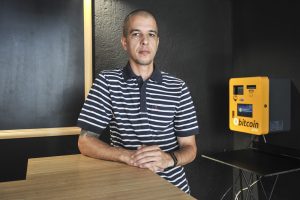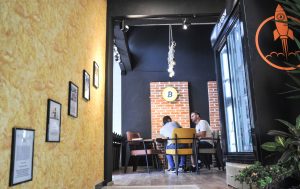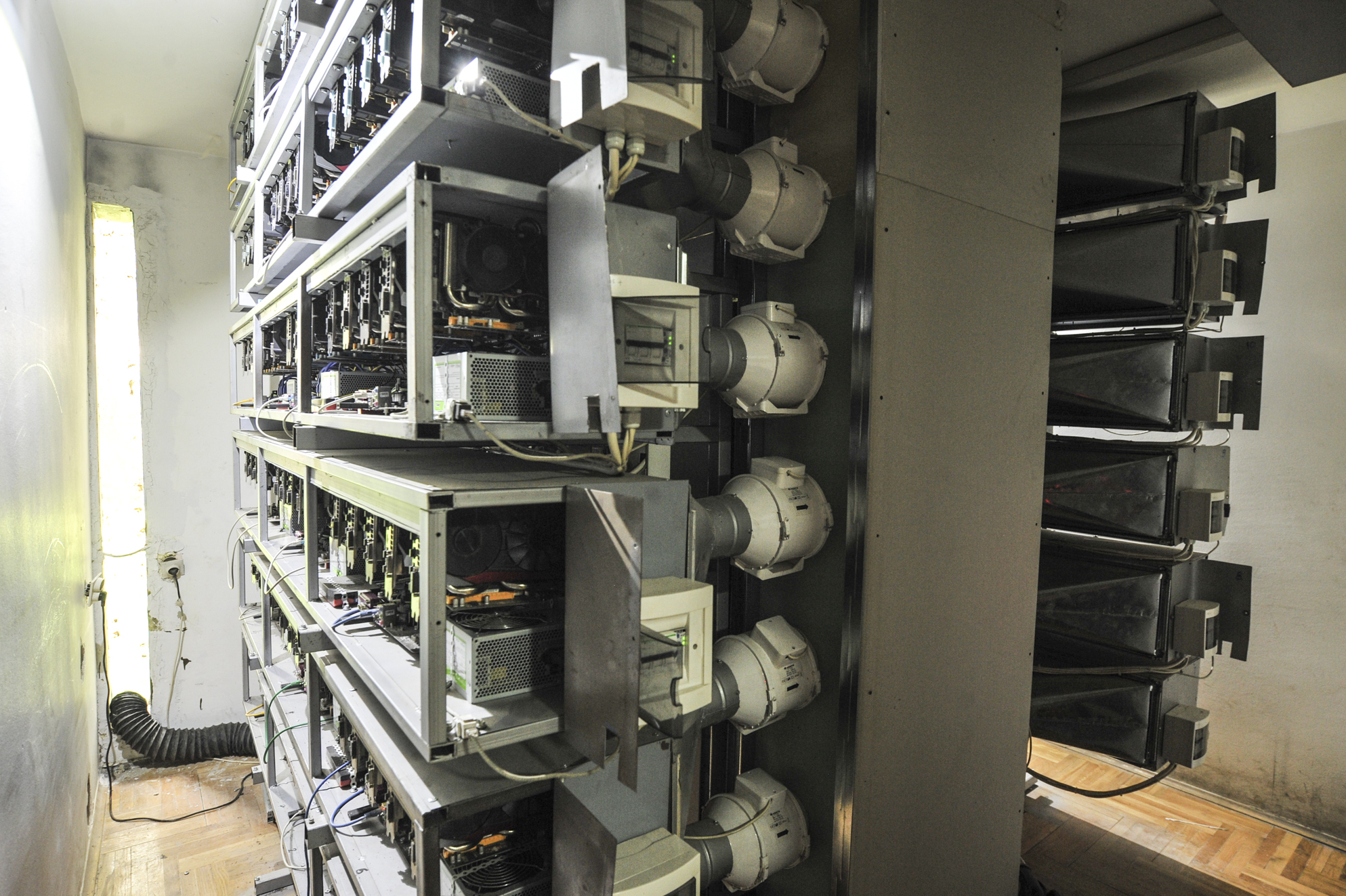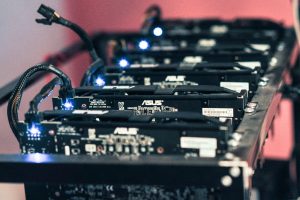Mining, trading, and developing peer-to-peer digital currencies, Kosovo techies are building a ripe environment for the country to experience the next technological boom.
Do you know, asked a willowy Milot Mehmeti while we sat in his bar, that one has to pay banks in Kosovo one euro just to deposit their own money? This is why, he explained, he does not have a personal bank account.
A cryptocurrency miner and trader by day, he is also the proud owner of Kosovo’s first business to accept payment in bitcoin, a peer-to-peer digital currency that foregoes banks as an intermediary. Mehmeti’s bar, opened only two weeks ago, is also home to one of the first bitcoin ATMs in the country, through which you can exchange your hard-earned euros for bitcoins, with a single unit currently valuing at 2,785 USD.
The bar, named Satoshi after the anonymous inventor of bitcoin, Satoshi Nakamoto, is a freshly-painted hole-in-the-wall with a lovely patio that hopes to become a hotspot for the cryptocurrency community in Kosovo, which has grown exponentially, especially after the market capitalization of cryptocurrencies overall (and Bitcoin in particular) surged last May.

Milot Mehmeti has been mining and trading cryptocurrencies for the past year and a half. He is also the operator of one of the first bitcoin ATMs in the country. | Photo: Atdhe Mulla.
“The community is dispersed right now. We want to tackle that,” explained Mehmeti, the 33-year-old founder of Cryptex, a Kosovo company that has been mining and trading cryptocurrencies for the past year and a half. According to him, there is still a stigma against cryptocurrencies, and this is partly why the community is not sharing information amongst themselves.
An aura of mystery and questionable legality shrouds cryptocurrencies almost everywhere in the world. This is mostly due to their novelty, as bitcoin, the first peer-to-peer currency, was invented only in 2009.
Like elsewhere, cryptocurrencies have not yet been regulated in Kosovo. There has been no move to ban them, either.
But a combination of potential high rewards, the lack of investment opportunities, and a high internet penetration rate has made the country a particularly ripe environment for a cryptocurrency mining and trading boom.
Out of thin air
While digital currencies can seem abstract, money itself is an abstract notion: the paper money we use has no intrinsic value. Until 1971, when the gold standard was abolished, paper money meant something – it was tied to a country’s gold reserves. Since then, the value of a fiat currency, a coin produced by the central bank of a state, is based on the state’s guarantee and our faith in it.
So when Satoshi Nakamoto released the paper “Bitcoin: A Peer-to-Peer Electronic Cash System” in 2008, the question was not whether a virtual currency would ever be adopted, but how this invention could ensure that people would not be able to fake money, or spend it more than once without involving a third-party, such as a bank, to vouch for the transaction.
Nakamoto proposed a decentralized network of ‘nodes,’ all of which would have access to and at the same time host a common public ledger. These computers would also verify all transactions, timestamp them in a chain of encrypted record divided into blocks. In 2009, he put the network online, and the blockchain was born.
While blockchain was invented with bitcoin, the technology cannot be simply reduced to the currency. The underlying principle of blockchain – the decentralization of a public record which could contain a system of any and all sorts of data from financial transactions to social media posts – has garnered widespread support.
To this day, bitcoin is the most successful cryptocurrency, and with most states permitting its use and some major investors backing it, its value has steadily increased. Additionally, bitcoin’s value is supposed to increase further because by design, the number of tokens that can ever be produced is limited to 21 million. With the exception of the first 50 bitcoins Satoshi distributed, all the remaining tokens need to be ‘mined’ by computers, which are part of the network connected through mining software.
Mining bitcoin and most other cryptocurrencies involves a competitive process of finding ‘the proof of work,’ which allows certain miners to add a block to the chain. Once the block is verified by all and added to the chain, the miners get rewarded with tokens – bitcoin or others – which in turn can be either saved in digital wallets, or exchanged in platforms like Coinbase, Poloniex, and Kraken.
But, bitcoin’s acceptance around the world has increased both the value of the coin and its pool of miners, making the mining of the currency unprofitable (unless one owns a Chinese bitcoin mine).

Satoshi, the first bar in Kosovo to accept bitcoin, opened on July 19. Articles chronicling the history of bitcoin line the stairs.| Photo: Atdhe Mulla.
“At first you could mine with a common computer,” explained Ermal Sadiku, managing director of LinkPlus IT and a cryptocurrency aficionado. “I started mining when it was extremely easy,” he said, adding that he would generate three to four bitcoins by just leaving his computer on overnight. “I used up my coins playing World of Warcraft, or Dragon Soldier. It was a way for me to buy things online, something like a shield or a sword in a game.”
If Sadiku had saved his coins, he’d be a millionaire now. The first recorded ‘real transaction’ with bitcoins happened in 2010, when Laszlo Hanyecz managed to pay for his pizzas with bitcoins. One bitcoin was valued at approximately 0.0025 USD at the time; it is worth almost 3,000 today.
Since bitcoin transactions are anonymous, it became a perfect currency to use for the sale of illicit products and services on the dark web (when the Silk Road was shut down in 2013, the FBI seized between three to four million of dollars worth of bitcoins) and is the preferred payment of hackers who demand ransom for one’s data.
But the currency has come a long way. Tens of thousands of legal businesses worldwide accept it, including Mehmeti’s bar in Prishtina, while multiple countries have regulated Bitcoin transactions and exchanges even if they haven’t adopted the currency itself.
Kosovo’s Central Bank, BQK, issued a press release in mid July, warning investors and users of cryptocurrencies that “the use of virtual money is not legally regulated and poses a risk that might result in financial loss.”
If Sadiku had saved his coins, he’d be a millionaire now.
But in July alone, two separate businesses, Satoshi Cafe and AlbVision, started operating one-way bitcoin ATMs in the span of a week, indicating an increasing interest in these currencies. A third machine, a two-way multi-token ATM, is expected to be brought by Bitsapphire by the end of the month to Innovation Center Kosovo, ICK.
In an email, BQK’s spokesperson Besnik Kada stated that “according to the law in power, Agencies that transfer money are obligated to get a licence from the BQK as non-banking financial institutions that provide payment services. Cryptocurrency ATMs are not considered as such.” Currently they operate in a legal loophole.
Bitcoin’s success has also helped start a torrent of new cryptocurrencies which build upon the blockchain and expand its use to more than a simple currency. Although Bitcoin still dominates the market at 48 per cent, Ethereum, a cryptocurrency platform and its coin ether, rose by 4,500 per cent between January and June 2017, dogging ‘the gold standard’ of cryptocurrencies as a close second since.
The Rig
Arber Arifi, the CEO and founder of Kosovo’s second biggest internet provider, Kujtesa, first heard of bitcoin in 2010, but dismissed it without much fanfare. Almost five years later, he was ordering a computer to play Counter Strike and was looking for a high-performance graphics card, which can also be used for mining cryptocurrencies because of its processing power.
“I was reading up on graphics cards, and I kept seeing the term cryptocurrency crop up,” I was told by an energetic Arifi.
“By the time the equipment arrived, I had read so much, I knew that computer was not gonna be for playing – it was going to mine.”
This was Arifi’s first test – he set up the computer and it mined 73 ethers in one night. “Imagine that value today! I spent it all,” he chuckled, as we sat in a small closed office surrounded by the loud whirr of dozens of ventilators, cooling down ‘the Rig,’ a pool of 333 GPUs mining Ethereum, which Arifi and his team built in 2015. The Rig has mined ether since day one.
“I ordered a larger amount of equipment to start a pilot-project to test and learn from it. My goal is to build a better rig, with better working conditions,” said Arifi, who turned an old decrepit house into a lab by tearing down the inner walls to make room for the computers. Although Kujtesa employees are interested in the technology, Arifi claims that this is his own pet project.
I ask him how much he invested in it and whether his investment paid off.
“We invested about 300,000 euros. It made that money a long time ago,” he answered, smiling. “The return on investment that the Rig brought, when I compared it to [the company] Kujtesa – it made me think twice.”
Mehmeti too started mining ahead of the boom in 2016. “We were mining ether since it was [valued at] 80 cents,” he boasted, adding that at the time, the only people who were mining were those from larger companies that had technicians who knew how to set up the rigs and ensure proper ventilation.
Today the number of miners and cryptocurrency investors in Kosovo has increased dramatically, according to dozens of local IT and business people I talked to. Most of them are mining either Ethereum, or other, less valuable coins.
One of the main reasons, experts argue, is the high internet penetration rate in Kosovo, which at 83 per cent per household is amongst the highest in the Western Balkans (in contrast, Macedonia, which has the highest rate of individual internet users per capita, has an internet penetration rate of 75.3 per cent per household).
This allowed Kosovars to get into the cryptocurrency market quite early. While some techies like Taulant Ramabaja talked about the use of bitcoin and blockchain since 2011, some started to mine around the same time and then stopped, and others joined only in 2015. The real boom, however, happened only after May 2017 when Ethereum’s value spiked from 50 to 90 USD, and soon after jumped to 350 USD per coin. It was a worldwide boom and Kosovars too were quickly swept up in the lucrative business.

The Rig is a pool of 69 units mining Ethereum 24/7. | Photo: Atdhe Mulla.
As of July, 800,000 euros worth of graphic processing units, GPUs, were imported in 2017 alone, according to data provided by the Financial Intelligence Unit. The number does not include black market mining rigs, which are freely advertised on Facebook and through classified ads, and whose prices have doubled since May.
“In Kosovo, the interest rises and falls according to how much the value of the currency goes up and down. I know a lot of people who have invested, who have no clue about finance,” I was told by Bitsapphire co-founder Taulant Ramabaja. “It terrifies me.”
One is not making money out of thin air, although it sounds like that.
“It has become so popular that everyone is talking about this: you hang out with police, people who work in government, business people, everyone’s interested to mine because someone in their family started,” explained Arianit Fazliu, co-founder of the web development company Kutia. Fazliu himself started mining ether and a couple of other coins last May – but it was “already late.”
At the time, according to Sadiku’s calculations, one set with seven GPUs could generate about 525 USD worth of ethers per month. If calculated today, the same set would generate a profit of only 250 USD, both because Ethereum’s value has gone down since June and because the difficulty of mining has increased exponentially. With a single set costing as much as 4,700 euros in Kosovo right now, the return of investment is neither as quick nor as certain as it used to be.
“People have been misinformed, the biggest winners were those who sold equipment,” claimed Fazliu, adding that some people ordered equipment in May and are still waiting for the rigs to arrive.
The requirements for Ethereum mining are also bound to change very soon, Fazliu explained, making the current equipment outdated.
“One is not making money out of thin air, although it sounds like that,” Sadiku explained, adding that the costs of electricity, internet, hardware and machine maintenance add up. “You solve problems and get rewarded with ether or bitcoins, and then money varies on how much you sell them for… This problem is not being clarified. People are thinking that the moment you plug the machine into the internet, millions of euros will appear in your bank account.”
Multiple people I spoke to agreed that the booming interest in cryptocurrencies in Kosovo might also be a result of the lack of investment opportunities.
“It’s very difficult to invest money in Kosovo, that’s why you have a lot of similar businesses: there are many gas stations, many pools, because people are not very innovative and don’t have the audacity to invest in new things,” Sadiku explained, adding that another contributing factor might have been the electricity tariff change in April.
With the value of currencies changing on a daily basis, the biggest rewards can be reaped in trading coins at the right moment. In a span of two weeks for example, Ripple’s XRP token, used for processing payments between banks, jumped from 0.02 USD to to 0.3. “Millions of dollars were made in one day,” Fazliu told me.
Arifi has a team of professional traders, while Sadiku had only personally dabbled in trading. The prices fluctuate so much that it can be disheartening for some.
“People get tired, talk against it, stop believing in the technology and leave,” explained Mehmeti.
“It’s an early speculative surge,” Sam Crawford, a New-York based financial analyst told me, adding that it was too early to tell whether it is similar to the late ‘90s dot-com bubble, especially considering that the cryptocurrency market represents only “fractions of a tenth of a percentage point of the global market.”
“Everyone is in this for making a profit – I am too – but I think the greatest profit would be if it’s adopted as an actual currency,” admitted Fazliu.
Security Matters
“We know today that internet is breachable on every level… even the most secure servers of banks and intelligence servers are breachable – it’s just a matter of time,” Arifi told me as we petted one of the six stray dogs living at the lab. “But blockchain is the exact opposite – it is the only technology which is still not breachable.”
Since blockchain is a distributed ledger, not fixed to a single server or computer, to hack it one would need “to break the history of every block,” Arifi explained. According to Nakamoto’s original paper, as long as the majority of nodes in the network were “honest,” or not attacking the system, and had the most processing power, the system would be secure.
While the theory might be sound, in practice the cryptocurrency market has been plagued with fraud and hacking scandals, making this “new area to the world economics,” as Crawford calls it, suspicious. In 2014, for example, Mt.Gox, the biggest exchange platform at the time, filed for bankruptcy after noticing the theft of almost 800,000 bitcoins.
Ethereum, which has been adopted by many start-ups and whose platform is being used to crowdfund new solutions for “smart contracts” (also called Initial Coin Offering, ICOs), has also been plagued by scandals. In 2016, a hacker managed to steal ethers worth over 50 million USD from the DAO, while just last month, there were two major hacks: one while CoinDash’s initial coin offering was in process; the other a result of a bug in the wallet app Parity.

The number of Kosovars who mine has increased drastically in 2017. In the photo, three sets of GPUs mine in a private cellar. | Photo: Atdhe Mulla.
“Every beginning has its own risks. While blockchain is 100 per cent secure, the moment you make a transaction or open a wallet, it is the critical moment when others have access to your communication,” Arifi explained.
Cryptocurrency wallets function like bank accounts, allowing users to receive or transfer tokens. While there are a large amount of wallet apps available, the offline ‘cold’ wallets, especially hardware wallets, are the safest.
“There are plenty of wallets that have no private keys – one should be careful, there are a lot of scammers who are using the opportunity in this emotional state to use someone who doesn’t have the right information,” Mehmeti told me.
Sadiku too said that when it came to security breaches, they were due to “human error” rather than a blockchain one.
“Hundreds of thousands of credit cards are hacked on a daily basis, but that’s is the good thing about having a third-party – the bank guarantees to get your money back,” he concluded.
But, is this legal?
It is difficult to regulate a currency whose raison d’etre is to escape regulation, and as the global cryptocurrency market expands, governments will be challenged to provide an appropriate response. While some states in the US have regulated the use of virtual currency, it is still in the phase of “early adoption,” Crawford explained.
While the European Union recognizes virtual currencies “as an innovation in the financial sector,” the Council agreed to make amendments to the anti-money laundering, AML, directive, demanding that virtual currency exchange and transfer service providers identify their clients.
Governments are slow. This is gonna be a great drama, it’s not a story that ends quickly.
“There’s a major political risk in that the world’s governments have a pretty strong vested interest in not allowing a large, robust challenger to their controlled fiat currency system,” Crawford said, adding that it is an open question as to how they will deal with it.
“Governments are slow. This is gonna be a great drama, it’s not a story that ends quickly.”
“When cryptocurrencies are adopted in the world market, there will be more security,” Dardan Nuhiu, the director of the Kosovo Financial Intelligence Unit told me. “This has not happened yet.”
Nuhiu’s office, which became a member of the informal network of international financial units, Egmont Group, in February last year, has been following international and local developments in the cryptocurrency market with great interest.
The unit shares the reservations of their colleagues worldwide, and although it is not officially a member of the Financial Action Task Force, FATF, it is waiting for the international network to adopt regulations before “rushing into a decision.”

Arifi’s original computer he used to mine cryptocurrencies with. It hangs on a wall in his office. | Photo: Atdhe Mulla
“There are some features that create some reservations for us who implement the law against money laundering and financing of terrorism,” he told me, listing anonymity and a lack of a central supervising body as key issues.
But the arrival of the bitcoin ATMs has forced Kosovo government institutions to shift gear. They have started consulting local and international experts to come up with a draft regulation.
“Our aim is not to ban them, but we do aim to regulate them,” Nuhiu said.
The representatives of the two current ATM operators, Satoshi and AlbVision, told me that their businesses comply to the EU AML directive, while Ramabaja, whose company is bringing a new ATM by the end of the month, also claimed to comply with Know Your Customer, KYC, protocol by scanning customer IDs.
“We’re being overcautious,” he told me.
Blockchain champions
“Money will be only one of the areas in which blockchain is used. Everything that we communicate, because of security and lack of supervision, will end up going this way,” I was told by Arifi, who is prone to quoting Don Tapscott and Julian Assange when explaining his vision for a blockchain-driven future.
“Philosophically it made me think a lot about the influence that the technology will have on us as humans….What is beautiful about it is that it’s not concentrated anywhere but is dispersed. There’s no Big Brother in this technology,” he continued.
The block-chain will definitely cause a disruption.
“In the future, we’ll have a unique digital identity…We won’t need to carry documents around when we go to see the doctor, everything will be on the blockchain.”
Arifi’s team of four head engineers are already working on a new software, their own coin, and trying to program a blockchain-based internet protocol.
“Even if we could fix and build upon Ethereum, it would be okay. I know how this sounds,” he said, brushing off his own modesty. “But even if we fail, it’s worth trying….It’s time for radical changes.”
Arifi’s grandiose plans might sound like pipe dreams to some, but he is not the only one in Kosovo who is interested in cryptocurrencies beyond mining and selling.

Nakomoto proposed a decentralized network of ‘nodes,’ all of which would host a common public ledger, while also verifying transactions, timestamping them in a chain of encrypted record of transactions divided into blocks. | Photo: Atdhe Mulla.
Ramabaja’s company, which provides blockchain-technology consulting, is also developing a start-up wallet app called Moonstone.
“The block-chain will definitely cause a disruption, because the cost-benefit of technology will change completely. Banks will unbundle – they have way too many functions right now,” Ramabaja explained.
“The wallet market, for example, is very competitive… but we believe that wallet providers will be the ultimate exchange in the end,” he said. “Moonstone is a multi-token wallet and has the best user-experience globally,” he boasted.
The app’s development started in 2015, and so far they have added three tokens to the wallet. The market depth of virtual currencies, however, is still “very small in comparison to normal currencies,” Ramabaja told me, which is why Moonstone is more of a long term investment.
Even Sadiku, whose company LinkSystem IT mostly provides ‘resource augmentation,’ or the outsourcing of IT specialists, is also working on developing a coin of his own based on Ethereum.
Sadiku plans to launch his coin with an ICO and to try to replicate the success of Tezos, which raised of 200 million US dollars in four days.
“ICOs are easy and online and quick… You put the whole concept up for sale. If i want to create this concept – this solution – it will have the name Ermalcoin or whatever, with these coins, which in fact are tokens, you set the first price and then the market decides whether they are ready to spend bitcoins or ethers on the idea.”
ICOs are a great way to attract global investors, and that is possibly one of the biggest advantages of a technology like this: it overcomes national borders.
“I think that blockchain technology is opportunity for us [in Kosovo]. If we somehow accept it, if we made some laws that would be good for the blockchain community in the world, we could be seen as an interesting country, attract investments for development and research,” Sadiku told me earnestly, adding that he was not saying that mining would always be profitable. “But blockchain as a technology is interesting. We could stand out.”
“Right now we live in the poorest country in Europe,” Sadiku said, adding with a laugh, “I would love to see this country to become at least second to last.”





